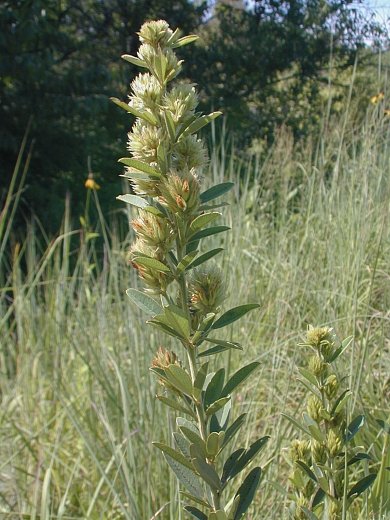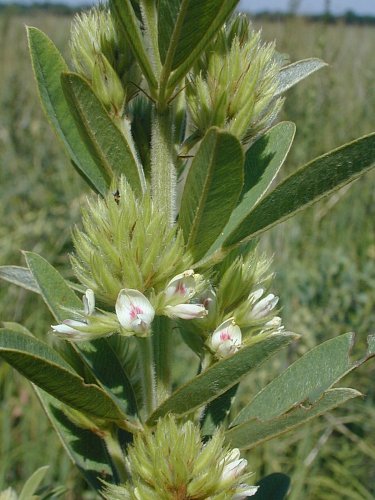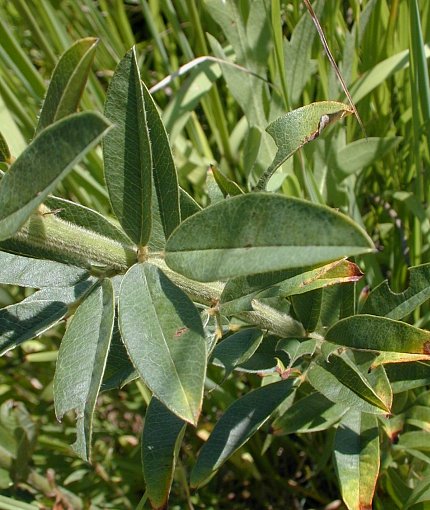Description: This perennial plant is 2-5' tall and unbranched, except for short stems bearing flowerheads in the upper half. The stout central stem is slightly ridged and covered with white hairs. The trifoliate leaves occur alternately along the stem on short petioles. Each leaflet is up to 3" long and 1" across, usually ovate in shape, with smooth margins, widely scattered white hairs, and a prominent central vein. Sometimes the surface of the leaves has a silky sheen. The apex of the central stem and some upper side stems terminate in elongated heads of flowers about 2-5" long and half as much across. Each flowerhead has numerous hairy bracts, from which the small white flowers barely protrude. Each flower is a little less than ½" long, and has 5 white petals with a patch of purple near its throat. There is a large upper petal and two smaller side petals, while the remaining petals are usually hidden from view. There is no floral scent. The blooming period occurs from late summer to early fall and lasts about a month. After blooming, the flowerheads gradually turn brown. The root system consists of a central taproot.

Cultivation:
The
preference is full sun and mesic to dry conditions. This plant is
adaptable to different kinds of soil that contain significant amounts
of loam, clay, sand, or rocky material. It adds nitrogen to the soil,
and is easy to grow. Drought resistance is very good, although some of
the lower leaves may turn yellow and fall off the plant.
Range & Habitat:
Round-Headed Bush Clover occurs in most counties of Illinois, although
it less common in the SE section of the state (see Distribution
Map). This native wildflower is occasional to locally common.
Habitats include
mesic to dry black soil prairies, sand prairies, gravel prairies, hill
prairies, loamy savannas and sandy savannas, limestone glades, sand
dunes near Lake Michigan, and open areas along railroads and roadsides.

Faunal Associations: The flowers are visited primarily by long- or short-tongued bees, such as bumblebees, large Leaf-Cutting bees, Andrenid bees, and others. Butterflies may suck nectar from the flowers, but they are not effective pollinators. The caterpillars of several species of skippers feed on the foliage, including Thorybes bathyllus (Southern Cloudywing), Thorybes pylades (Northern Cloudywing), Achalarus lyciades (Hoary Edge), and Epargyreus clarus (Silver-Spotted Skipper). The caterpillars of several moths also feed on the foliage, including Utetheisa bella (Bella Moth), Dasylophia anguina (Black-Spotted Prominent), and Ptichodis herbarum (Common Ptichodis). Other insects feeding on this plant include Everes comyntas (Eastern-Tailed Blue), Tetralopha scortealis (Lespedeza Webworm), Pachybrachis carbonarius (Leaf Beetle sp.), Calomycterus setarius (Imported Long-Horned Beetle), and various Alydus spp. (Broad-Headed Bugs). Because it is high in protein and palatable, many mammalian herbivores eat the plant during different growth stages, including deer, rabbits, groundhogs, and livestock. An overpopulation of these animals may interfere with this plant's establishment. The seeds are eaten primarily by upland gamebirds, including the Mourning Dove, Bobwhite, and Wild Turkey. During the winter, the seeds are eaten by the Slate-Colored Junco.

Photographic
Location:
The photographs were taken at Meadowbrook Park in Urbana, Illinois.
Comments:
This is a
robust and beneficial plant, although not particularly showy. It is
fairly easy to distinguish this plant from other members of the Bean
family, such as the tick trefoils and other bush clovers, by the stout
bristly flowerheads and their small white flowers. However, there is
some variability in the appearance of this plant across different
localities.